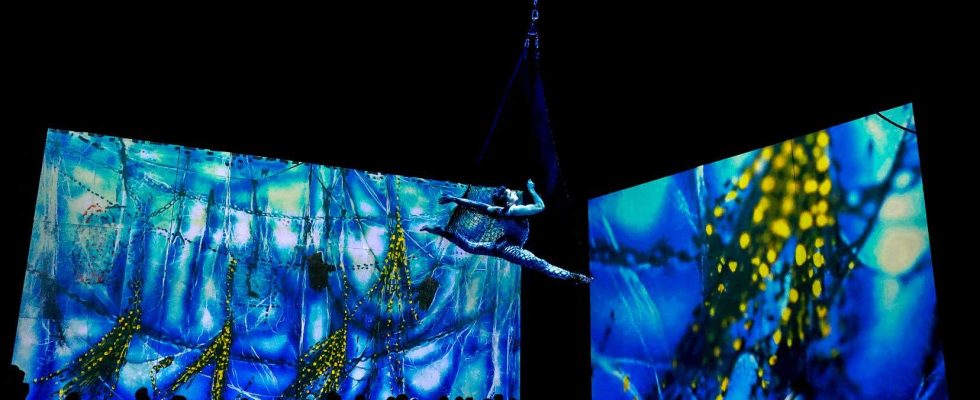Between the paintings projected on the walls and the dancing bodies, we don’t really know who is leading the show. On the show stage Life-size Riopelle, of 7 Fingers, the abundant painting of the man whom André Breton called “the superior trapper” and the supple bodies of the circus artists are in intimate conversation. And the small room at the 7 Doigts studios, where the show is presented, on Saint-Laurent Boulevard, in Montreal, is the ideal place for this explosive meeting. Surrounded by these canvases, the circus artists in turn embody the painter, Riopelle, who created them, the animals who inspired them and the spirits they invoke.
Samuel Tétreault, co-founder of 7 Doigts, who directed the show, was ideally suited to conceive this hybrid show, inspired by the life of Riopelle. He was a teenager, studying at the circus school, when his father, the gallery owner Michel Tétreault, exhibited for the first time the famous Tribute to Rosa Luxemburga huge high point in Riopelle’s life, a retrospective look at his own life.
“As a teenager, I was immersed in visual art. From time to time I went to see the openings at my father’s gallery on Prince Street. And then, in the house, we had works of art everywhere. So I was generally quite sensitive to visual arts. I was discovering Riopelle’s work quite a bit at that time. It was fabulous to see this great work, this great fresco, it was impressive, and it still is,” he said in an interview.
Human finitude
In doing the research for this show, which is accompanied by an exhibition and an immersive experience in the life of Jean Paul Riopelle, Samuel Tétreault explored his work in depth, beyond the more well-known series such as the mosaics of 1950s, the Icebergs Or The tribute to Rosa Luxembourg. It must be said that Riopelle created around 7,000 works in his life, he notes.
The show opens with Riopelle aging, looking in his hands for what he still has to paint, something “fragile and immortal”. Tétreault also emphasizes that Riopelle’s work bears witness to the power and physical decline of the artist, a human finitude of which circus artists are extremely aware.
Life-size Riopelle allows us to measure the relationship between the visual arts and the movement arts. “There are affinities between the practice of visual arts and that of movement arts, especially in the context of Riopelle’s work. [Pour réaliser ses oeuvres], there is a physical deployment reminiscent of that of a circus artist. When you create a painting that measures four meters by three meters high, using a spatula or painting knife, or when you paint a 40 meter fresco, there is a display of energy that is quite extreme. » When observing certain works by Riopelle, we find a line that a dancer could have embodied and, conversely, circus artists will pick a movement from the abstraction of a canvas.
The 7 Fingers studio room, which is open to the public for the first time, offers an immersive experience. The audience surrounding the stage is itself surrounded by projections of the works, in a spirit of correspondence. This room cannot accommodate more than 125 people.
The text, signed Marie-Christine Lê-Huu, punctuates everything perfectly, offering, with strength and restraint, a showcase for circus acts.
Inuit inspiration
It is Saali Kuata, an Inuit circus artist who also does photography, who embodies the portion of the show devoted to rope games where Riopelle was inspired by this Inuit tradition, in a rope show.
“I wanted to imagine a dialogue between a young Inuit circus artist from today and an artist from another era, Riopelle, rather than taking sides with one point of view or the other,” says Samuel Tétreault. I did not feel comfortable presenting works that were clearly inspired by Inuit culture(s) without taking the current situation into context. » Although admiring Inuit cultures in his time, Jean Paul Riopelle approached these questions with “the biases of the time”, which have changed today, he specifies.
Like the show, the exhibition was organized under the attentive eye of Yseult Riopelle, and exposes the deep bond that linked the artist to nature. “Yseult Riopelle was a consultant for the use of the works and respect for the integrity of the works,” he says.
Riopelle said that nature was his only inspiration, continues Tétreault. “He said: “You can’t see nature, you can only feel it.” And to make you feel nature, the best way to do it is to borrow its methods. So he himself was trying, in quotes, to become nature. »
The exhibition, which presents around twenty works by Jean Paul Riopelle, from various media and origins, also offers a section devoted to Inuit art, and presents an interview with the artist Saali Kuata.
Life-size Riopelle arrives as a high point of the festivities celebrating the centenary of Jean Paul Riopelle, born October 7, 1923 in Montreal. This will be followed, planned for 2025, by the inauguration of a pavilion in homage to the painter at the National Museum of Fine Arts of Quebec.
